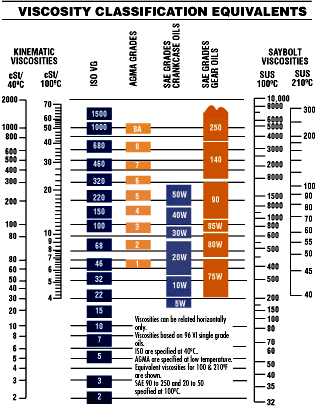
The idea for the model is that the force exerted to displace a liquid, which is located between two plates arranged in parallel, is measured. For calculations, the uniform SI unit kg/m*s is used. It is provided in data sheets or laboratory reports in mPas (millipascal-seconds) or cP (centipoise). In the case of dynamic or “true” viscosity, flow resistance within a liquid is measured.


In highly viscous oils, these layers are bound together much more strongly and are therefore less moveable. In physical terms, viscosity reflects the internal friction which ensues when neighbouring liquid layers are displaced. If the compressor is lubricated using the wrong type of oil, such as an HLP 32 hydraulic oil, then problems will only become apparent after a few thousand hours.
100 cst viscosity equivalents sae iso#
If, for example, an ISO VG 320 oil is used in a screw compressor which should be supplied with an ISO VG 32 oil, usually the damage will occur after just a few minutes. If the wrong viscosity is chosen, the catastrophic consequences can be more drastic and occur faster than if the wrong type of oil is used. If an oil is used as a hydraulic fluid, it must in turn demonstrate particular fluid behaviours in order to enable the desired power transmission. Conversely, if it is too thin at the operating temperature, it will not be able to guarantee a sufficient lubricating film to protect it from wear. When a machine is started, the oil must not be to viscous because otherwise it will not reach the areas that need to be lubricated in time. At the same time, however, it is the most decisive key figure for describing an oil’s capability to build a separating lubricating film between two moving parts. Viscosity itself is not a characteristic of quality.Ī viscosity reading simply tells you how thick or thin an oil is. Whether thin or thick, the viscosity of a modern lubricant is accurately adjusted nowadays to suit its intended use. The viscosity of this paste was, however, altered in Roman times, for example with honey. “Viscous” therefore originally meant “sticky like birdlime”. Glue used to be extracted from the mistletoe for catching birds. The concept takes its name from the typically gooey sap that comes from mistletoe berries (viscum). Nearly all physical media and foodstuffs have a specific viscosity. Thin lubricating oils are mostly deemed to have low viscosity and thick lubricating oils are deemed to have high viscosity.īut viscosity isn’t just measured for lubricating oils or paints and adhesives. And the lower the viscosity, the thinner the oil. The higher the viscosity, the thicker the oil. Viscosity nowadays means a measurement of the flowability of a lubricating oil or hydraulic fluid. Several modern devices have been installed in the laboratory just for determining viscosity alone. OELCHECK principally assesses viscosity in oil samples at 40☌ and 100☌ and calculates the viscosity index from this.


Since it can change when an oil is being used, it is one of the most fascinating and extensive topics in lubricant analytics. It is also dependent on temperature and can be infl uenced by special additives. It plays the decisive role in the choice of accompanying lubricant as it describes its fl uid characteristics. Viscosity is the most important physical characteristic of an oil. The single most important physical characteristic of any oil


 0 kommentar(er)
0 kommentar(er)
